Unit - 4
Digital Manufacturing: 3D Printing & Drones
History:
The concept of 3D printing was imagined back in the 1970’s, but the first experiments are dated from 1981. The first 3D printing attempts are granted to Dr Kodama for his development of a rapid prototyping technique. He was the first to describe a layer- by- layer approach for manufacturing, creating an ancestor for SLA (or Stereolithography): a photosensitive resin was polymerized by an UV light. Unfortunately, he did not file the patent requirement before the deadline.
In the meantime, Scott Crump, a co-founder of Stratasys Inc. filed a patent for Fused Deposition Modelling (FDM). In less than ten years, the three main technologies of 3D printing were patented and 3D printing was born!
In 1992, the Fused Deposition Modeling patent was issued to Stratasys, which developed many 3D printers for both professionals and individuals. From 1993 to 1999, the main actors of the 3D printing sector emerged with various techniques:
ZCorp and binder jetting based on MIT’s inkjet printing technology, they created the Z402, which produced models using starch- and plaster‐based powder materials and a water‐based liquid binder
Arcam MCP technology and Selective Laser Melting.
At the same time, we can see that more and more new CAD tools, allowing to create 3D models, are becoming available and developed, with, for example, the creation of Sanders Prototype (now known as Solidscape), one of the first actors to develop specific tools for additive manufacturing.
Charles Hull was awarded the European Inventor Award in the Non-European countries category, by the European Patent Office Price in 2014.
In 2005, ZCorp launched the Spectrum Z510, the very first high-definition color 3D printer.
In 2008, 3D printing reached an even greater media presence thanks to another medical application: the first 3D printed prosthetic limb.
This amazing medical 3D printing project incorporated all parts of a biological limb, was printed ‘as is’, without the need for any later assembly. Nowadays, combined with 3D scanning, 3D printed medical prosthesis and orthosis are more and more cheaper and faster to get for the patient.
2009 was also the year Sculpteo’s online 3D printing service was created, one of the pioneers of the now flourishing online 3D printing services, another step toward 3D printing accessibility!
In 2010, Urbee was the first 3D printed car. Its body was fully 3D printed using a very large 3D printer. Now, the 3D printed car is progressively becoming a reality, and additive manufacturing is taking more and more space in the automotive sector.
3D printing technology keeps on evolving, and progressing. New 3D printers are being issued regularly, they are more efficient, they print faster, and they give access to new 3D printing materials. Technologies like CLIP(DLS) are being developed by Carbon, making the printing process even faster and more accurate than ever.
Additive manufacturing is now offering the possibility to create parts for demanding sectors using advanced materials such as extremely resistant and rigid materials, or professional flexible plastics: we call them high performance materials. It is also a way to implement more sustainable manufacturing using bio-based materials, with a series of Nylon PA11 materials.
Survey:
In 2019, the 3D printing service bureau market is arguably more competitive than ever. The number of independent service bureaus is growing, as barriers to entry particularly the cost of machines are reduced. At the same time, some hardware manufacturers are offering services as part of their business model. Online manufacturing platforms, based on a Manufacturing-As-A-Service model, are also helping to shape the services landscape by offering companies access to a global network of suppliers, on demand. For OEMs, never has there been more choice in the range of potential manufacturing suppliers. On the other hand, all of these factors mean that service bureaus will need greater agility and innovative strategy in order to adapt to a market that is in a constant state of flux. In spite of the competitive landscape, however, the vast majority of respondents to the survey seem content with the performance of their business and are looking forward to continued growth over the next 12 months. And there’s much to be optimistic about. The 2018 edition of the annual Wohlers Report reports that independent service providers generated an estimated $2.955 billion in revenue worldwide in 2017, up 36% from the $2.173 billion reported for 2016.
Service bureaus continue to innovate product development and production by providing valuable specialisms across a range of 3D printing technologies and ancillary services like postprocessing, 3D modelling and 3D scanning. From a specialisation perspective, prototyping and polymer 3D printing remain key areas of expertise for many of the service bureaus surveyed. However, there are also exciting opportunities in other areas, such as metal 3D printing and the emerging industries that are in the early stages of their 3D printing adoption. The industry’s shift towards end-part production is another a key opportunity for service bureaus to establish their expertise, although this is not without its own challenges namely quality control and repeatability. Overall, as the technology continues to mature and the industry continues to grow, service bureaus will be in a strong position to capitalise on their expertise. A recent report by market research firm, IDC, forecasts that spending on 3D printing services will reach $4.8 billion in 2022 indicating a very promising outlook for the sector in the years ahead.
Design Principles:
1.Innovative
If a design is not innovative, it can happen because there are too many restrictions. There are lots of reasons why it doesn’t happen. That is the worst thing that happens is that when something is not innovative, it means that someone lacks the initiative to go and make and to have that creative thought while making it unique. Today we think of designers like it is a bad word in a lot of manufacturing companies. They think of it as complexity and adding time and cost. I think it is the opposite. If you are using a good designer then you make it more valuable.
2: Good design makes a product useful.
Design can get in the way. User interfaces are a good example where it does apply; in a physical hard product, not necessarily. On a lot of these principles, I feel better about them by inserting the word good design can make the product useful or more useful. It does not mean a product is not a good design if the design doesn’t make it useful. It may be useful without the design. If you are still learning design, these principles are really a good place to start when you think about design principles for 3D printing.
3: Good design is aesthetic.
This is a little bit more where 3D printing needs to improve and needs to create this as a hard and fast design principles for 3D printing. Feeling something is as important as the aesthetics of something. You have a color pattern texture; all the senses go into aesthetics. When you are missing some of those or they are just not normal to us and they go against how we feel about something, then we are pushing against it. That is why we are having a lack of acceptance. It is the emotional connection that the person experiences by touching the design.
4: Good design makes a product understandable and Good design is unobtrusive.
A good design can make a product understandable or should make it understandable. This is the role of product design. It is neither decorative nor work of art. I don’t know with the definition of unobtrusive. Design just makes something understandable in the sense that you are creating an intuitive sense to how something works. It is making sense on a psychological basis. You know how it works and how it is used. You can have a product that is very complicated to use and the design does not help you to understand it.
6: Good design is honest.
A good design has integrity and is honest about what it is. A good example of this is a terrible design element was that trend in the 1970s and 1980s where you have vinyl fake wood grain on the side of your car that wasn’t actual wood. There was a time when it was made of wood. It was fine. There is honesty and integrity on that. Now, laminated wood is on the sides of cars function as ornament that is not functional and does not have integrity.
Tools
Print-Removal Blade

A print-removal blade can help carefully dislodge prints from the build plate
A print removal blade helps you to remove prints from your print bed quickly and easily. This tool is especially handy when you use an adhesive on the bed or a filament that sticks very well, like PETG.
You can get print removal blades with the handle perpendicular or parallel to the blade.
Screwdrivers & Hex Keys
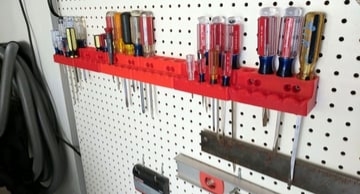
Screwdrivers and hex keys (also known as Allen keys) come with many printer kits and allow you to remove or add parts to your printer. With a set of these tools, you can access certain parts of your printer that may be sealed off with screws, the mainboard or hot end for example. These tools are essential to fix almost any part of a machine, including 3D printers, CNC machines, and more.
Glue & Other Adhesives
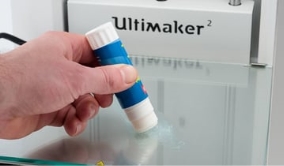
Adhesives are another vital piece of equipment for your 3D printer and can be used in a few different ways. Mainly, adhesives are used to provide improved bed adhesion for 3D prints, but they can also bond different components together.
Pliers & Tweezers

Pliers and tweezers can help you remove hot items, like a nozzle, and pick out small parts, like a screw from a V-slot extrusion. Pliers are more for grabbing larger items, while tweezers are for smaller items in small or hard-to-reach spaces. Pliers can be used to remove support material from a part, hold hot parts, strip wires, or cut filament.
Utility Knife

A utility knife is a sharp blade, like an X- Acto knife that can be used for various tasks, from opening up new boxes of filament to cutting a sharp edge on the filament to load it easier. Utility knives are also super useful for slicing a PTFE tube evenly by hand (no high points), trimming elephant’s foot on prints, removing supports, and more.
Utility blades can come in individual or multi-pack sets, and their durability can depend on the construction and material of the blade and handle. Two examples of utility knife sets include Craftsman’s utility knife or Workpro’s folding knife set.
Digital Caliper
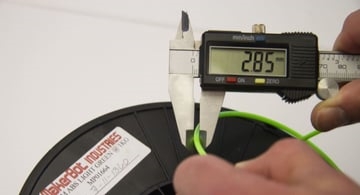
A digital caliper is another great tool to have on hand. It allows you to achieve accurate designs and perform dimensional tests on your printer. This tool is a measuring scale with a digital display for more accurate, less eyeballed measurements. You can use them on your 3D printer to more accurately tune your E-steps and flow settings to prevent over-extrusion or under-extrusion; for designing, you can use them to replicate another part through precise measurements.
Rotary Tool

A rotary tool is a bit more expensive than most of the other tools on this list but is super helpful in many scenarios and can be used for many tasks, including cutting, sanding, polishing, drilling, engraving, carving, grinding, sharpening, and more. The tool spins at a usually adjustable RPM so you can use it to modify or finish (sand and polish) your 3D printed parts or, if need be, fix your printer.
Filament

As you probably know, filament is the food of 3D printers and, if you’re into 3D printing a lot, you may run out of it a lot. Filament is used to 3D print things and comes in different materials, colours, diameters, finishes, tolerances, brands, and more. Filament is usually single-coloured (though there are some rainbow options so having a few spools of the same materials in different colours, or different materials is a great idea.
Nozzles

Nozzles are the tip of an FDM 3D printer’s hot end and are where the melted filament comes out. Nozzles can abrade and degrade over time, which will lead to inconsistent extrusion, so it’s important to have some spares in case of jamming or clogging. Nozzles come in different materials from brass and steel to tungsten and ruby-tipped; the more conductive, abrasion-resistant, and hard the nozzle is, the better.
PTFE Tube & Couplers

A PTFE tube is Teflon tubing that’s included in most extruder setups, whether Bowden or direct drive. PTFE tubes are connected to the hot end and extruder via a PTFE coupler, and filament travels through the tube. These parts can wear over time, and you may want to replace them after a while, especially if your couplers have a weak spring or the tube is scorched on the hot end side.
Rollers

Rollers are commonly used on printers, like the Ender 3 or Artillery Sidewinder X1, that use V-slot extrusions to move on the X-, Y-, or Z-axis. Rollers are bearings with wheels on the outside that are supposed to provide smooth motion on the axis they are used on.
Belts

Lastly, belts are used on most 3D printers on the X- and Y-axes and are connected to the carriage and stepper motor. Belts, especially when over tightened, can wear and many 3D printer manufacturers use cheap belts that aren’t known for lasting long with frequent use. You may want to keep some spare belts around for replacing your old ones on your 3D printer every so often.
3D printing is growing in both public recognition and overall added value, beyond prototyping and simple design. It is a revolutionary technology on the cusp of full-scale manufacturing capacity.
Manufacturing 4.0
Today’s manufacturing sector is far more innovative than the classic manufacturing processes of prior generations. Advanced manufacturing is revolutionizing the Fourth Industrial Revolution up and down the supply chain.
3D printing is no exception. 3D printing utilizes robotics and sophisticated design software, as well as adaptive physical hardware and tooling.
The Rise of Rapid Prototyping
3D printing has a bright future in the world of “Industry 4.0” and the advanced manufacturing sector of cyber-physical systems. It is invaluable for its ability to engineer real-life 3D models of 2-dimensional products and concepts. It is the preferred method for rapid prototyping and allows individual online customers to produce their own custom, end-use parts.
Rapid prototyping is a cost-effective and time-saving alternative to traditional prototype production methods
Prototyping Vs. End-Use Production
The ever-evolving technology of 3D Printing offers benefits for both prototyping and end-use manufacturing. Below are a few advantages of each process:
Prototyping:
End Use:
Increasing Printing Reliability
While international quality management organizations continue to fine-tune the technical standards for reliable 3D printing output, the best manufacturers have already earned ISO9001:2015 and ASD9100D certification—an important quality designation trusted by customers around the world. Many fabricators also have in-house standards like inspection reports and finishing certifications to help streamline production and consistency.
Innovations in 3D Printing Materials
At its earliest stages, 3D printing was limited in the raw materials it could use for fabrication. By contrast, today’s 3D printers offer an array of materials, suitable for a host of new prototyping and end-use manufacturing.
The spectrum of metals available in additive manufacturing is growing year by year, with 3D printers now able to use aluminum, stainless steel, titanium and cobalt-chrome and other specialty metallics. The variety of plastics and polymers is even more expansive, including PLA, ABS, resins, nylon, PETG, TPU and ASA. In the near future, the industry may see a variety of new material chemistries that offer versatile raw materials yet undiscovered.
Use cases:
How Delft hyperloop has embraced 3D Printing
3D printing is great for prototypes, and there is probably nothing more prototype-y than the Hyperloop. The Hyperloop concept was dreamed up a few years ago by Elon Musk as a potential.
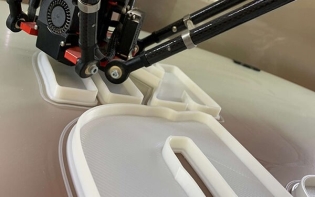
AM brings unparallel design freedom to fluid dynamics
A new eBook from 3D Systems is available for download, highlighting many of the cutting-edge industries making the most of additive manufacturing in the vast and varied world of fluid dynamics.
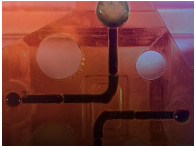
3D Printing finds home with audiophiles
With the aid of a 3D Systems SLS printer and some simulation software, UK-based industrial designer company Node has created their HYLIXA speaker design

The term “drone” usually refers to any unpiloted aircraft. Sometimes referred to as “Unmanned Aerial Vehicles" (UAVs), these crafts can carry out an impressive range of tasks, ranging from military operations to package delivery. Drones can be as large as an aircraft or as small as the palm of your hand.
Drones are meant to carry out tasks that range from the mundane to the ultra-dangerous. These robot-like vehicles can be found assisting the rescue of avalanche victims in the Swiss Alps, at your front doorstep dropping off your groceries and almost everywhere in between.
Because drones can be controlled remotely and can be flown at varying distances and heights, they make perfect candidates to take on some of the toughest jobs in the world. They can be found assisting in a search for survivors after a hurricane, giving law enforcement and military an eye-in-the-sky during terrorist situations and advancing scientific research in some of the most extreme climates on the planet. Drones have even made their way into our homes and serve as entertainment for hobbyists and a vital tool for photographers.
Engineering Disciplines:
Sourcing
As the first step in the manufacturing process, drones can be used to discover sources of raw materials which are necessary to manufacture finished goods. Equipped with cameras – drones can obtain quality aerial views from much lower heights than airplanes. At these lower altitudes, other geographical or physical characteristics of a region can also be obtained. This data can be analysed and used to create roads or other access to resources. Besides these obvious advantages, a drone is less expensive to own and operate than a plane and s smarter than a plane as it’s got all sorts of on-board electronics to let it do pre-program surveys.
Logistics Planning
Construction engineers often work in remote areas or over large sites that change rapidly over a short period. Drones can be used to provide a dynamic visualisation, flagging potential impacts and issues that might otherwise be overlooked, e.g., large plant movement and arrangements. Drones allow for the streaming of live feeds, which can be beamed directly to a control room for certain inspection requirements (e.g., crane clearance, logistics, personnel movement) allowing for real-time decision making. This, in turn, saves time from errors, reduces previously unidentified risks, and improves quality by aiding the decision process.
Increased safety
Drone technology is also a benefit to human safety. Because of their manoeuvrability and size, drones are able to get to places that might be difficult or even unsafe for engineers. A drone could inspect or repair the insides of vats or other vessels where it may be difficult or less safe for an employee to climb in and do the job. Drones can also be used in hazardous situations like combining chemical compounds or to obtaining samples of extremely hot or cold in-process materials.
Course Details:



Procedures
1 Remote pilot shall have attained 18 years of age, having exceeded 10th examination in English, and passed through ground/ practical schooling.
2 The ground training will be received at any dgca authorised flying schooling agency (fto), and include the subsequent concept subjects:
A) Primary radio telephony (rt) techniques along with know-how of radio frequencies.
B) Flight planning and atc approaches.
C) Policies precise to area of operations.
D) Primary understanding of concepts of flight and aerodynamics for fixed wing, rotary wing, and hybrid plane.
E) Airspace structure and airspace regulations with knowledge of no drone zones
F) Basic aviation meteorology.
3. The sensible training shall comprise of rpa in flight having stay element, and/ or simulated flight schooling to demonstrate control of rpa at some point of its operating situations, consisting of safe restoration at some stage in emergencies and gadget malfunction. Minimum syllabus and curriculum for schooling pill for remote pilot is given at annexure-ix.
4. The requirements contained in para nine.1 via nine. Three of these automobiles are not relevant for nano and micro class rpa pilots proceeding to perform in out-of-control airspace. But the proprietor and user will be absolutely privy to responsibilities for all components of flight safety during such operations.
References:
1. Internet of Things(IoT): Systems and Applications: Mehmet R. Yuce, Jamil Y. Khan
2. Cloud Computing – Concepts, Technology and Architecture Pearson Thomas Erl
3. Block Chain: Blueprint for a New Economy, O’Reilly, Melanie Swan
4. Designing Reality: How to Survive and Thrive in the Third Digital Revolution by Prof. Niel Gershenfeld.
5. Simon Haykin, “Communication Systems”, 4th Edition, Wiley India